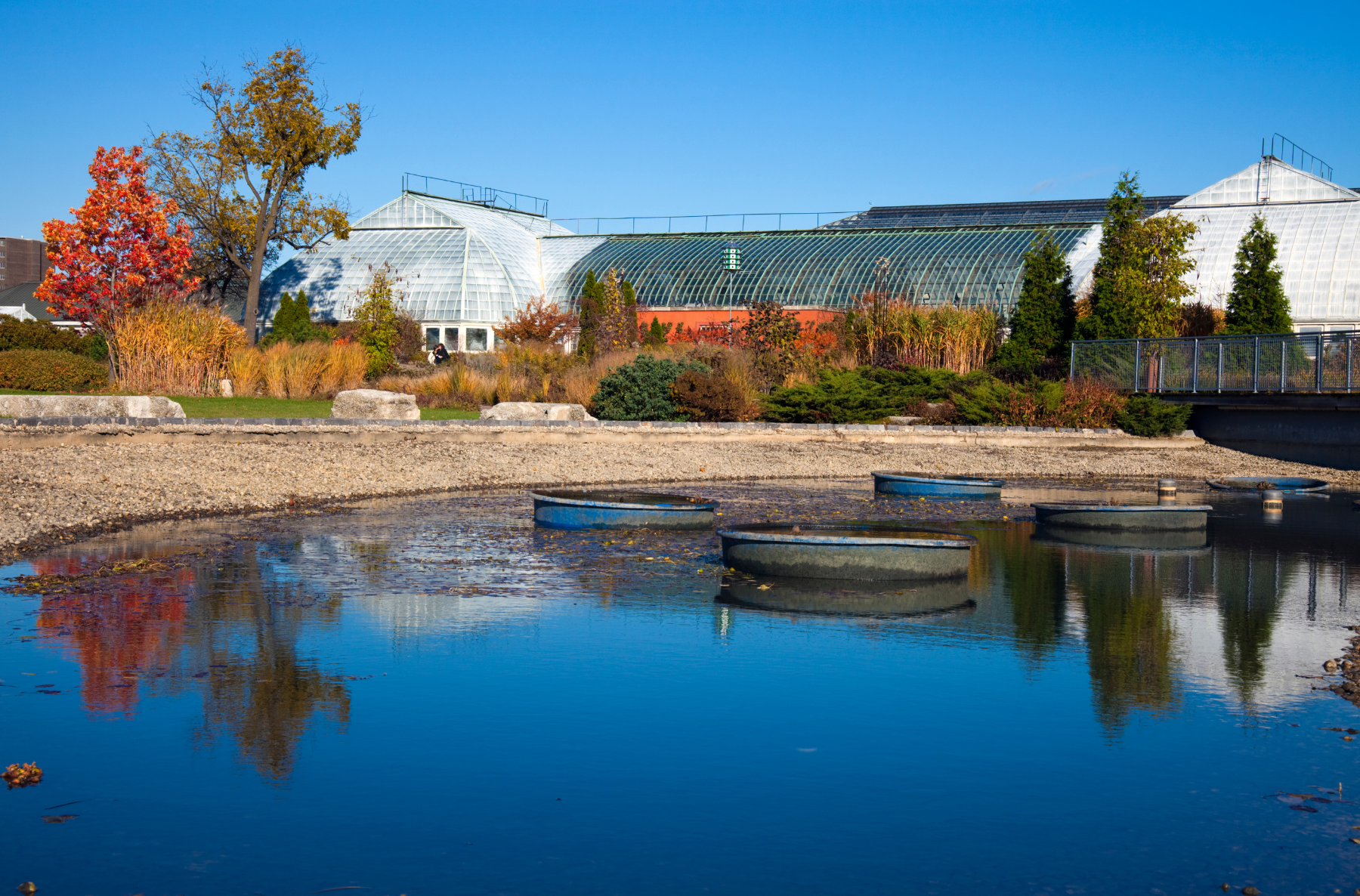
“Paradise Under Glass”: Chicago’s Two Conservatories
Published on December 28, 2023
The conservatories in Garfield and Lincoln Parks feature thousands of trees and plants from around the world in a serene, indoor setting. If you’re heading to Lincoln Park, we have two eATLAS Adventures to recommend: explore the park’s hidden gems or play our scavenger hunt of the zoo.
By Dave Lifton (@daveeatschicago)
Although the practice of growing plants in artificial, controlled environments dates back to Roman emperor Tiberius in 30 A.D., the modern greenhouse emerged during the 17th century in England and the Netherlands. They became common on estates so that the wealthy could grow warm-weather fruits that they discovered on their travels across Europe, namely citrus from the Mediterranean.

Innovations in glass-making and steel meant that, in the 19th century, greenhouses could become larger and more efficient. Around this time, the word “conservatory” began being applied to free-standing buildings or wings of houses where plant life was cultivated. In many cases, they were added to hospitals so that medicinal herbs and plants could be grown year-round.
Although greenhouses and conservatories are often used interchangeably, the accepted distinction is that greenhouses are where plants are grown, and conservatories are where they’re displayed once they’ve reached full bloom.
The growth of conservatories coincided with the rise of landscape architecture in public parks across Europe and America, and botanic gardens were built to bring natural beauty back to cities that were being transformed by industrialization, including Chicago. In 1874, a greenhouse was placed in Lincoln Park, on Stockton Drive south of Fullerton Ave., with an adjacent formal garden added in 1887. However, it was soon determined that more space was required, not just for show, but also to grow the many flowers found in the growing park.

Noted architect Joseph Lyman Silsbee was recruited to design the conservatory, and Mifflin E. Bel worked on the greenhouses. Construction on the Victorian-style building began in 1890, and the first of its four rooms, the Palm House, opened two years later. Over the next three years, the Fern Room, Orchid House, and Show House—the latter to be used for seasonal displays—were added to it. The Lincoln Park Conservatory was hailed as a “paradise under glass” and boasted “a luxuriant tropical growth, blending the whole into a natural grouping of nature’s loveliest forms.”
In 2022, the conservatory welcomed 82,000 visitors from all 50 states, 60 countries, and every neighborhood of Chicago.
A decade after Lincoln Park Conservatory was completed, the West Park Commission, which operated the parks on the West Side, decided to consolidate the conservatories in its three biggest parks—Garfield, Douglass, and Humboldt—into one. Jens Jensen, the commission’s general superintendent and chief landscape architect, designed the building.
In contrast with Lincoln Park’s Victorian feel, Jensen went with the burgeoning Prairie School approach, where the intent was for buildings to reflect the flatness of the Midwest, and the shape of the Garfield Park Conservatory was inspired by haystacks. Construction began in 1906 and it opened in 1908, with two acres of indoor display space.

Like its North Side counterpart, the Garfield Park Conservatory has rooms dedicated to palm trees and ferns, and another for flower shows. But it adds the Desert House with cacti and succulents, and the houseplant-filled Aroid House, whose centerpiece is a koi pond with glass Persian lilies made by Dale Chihuly that were installed in 2001. Guests can also find the Sugar from the Sun exhibit, which shows the photosynthetic process at work, plus 10 acres of outdoor gardens and an events space.

The Fern Room could be Jensen’s greatest creation. He wanted to show how the Chicago area might have looked millions of years ago, and filled it with rocky outcroppings and an indoor lagoon. During its construction, Jensen was dissatisfied with the way the waterfall sounded, and had it torn down and rebuilt several times. He instructed his stone mason to listen to Felix Mendelssohn’s “Spring Song” and try to make the water cascade as gently as the melody lines.
By the mid-1990s, the conservatory had fallen into disrepair due to years of neglect. The nonprofit Garfield Park Conservatory Alliance was formed by concerned citizens to raise funds to restore the building back to Jensen’s vision, and create programming to further its mission of education.
Both conservatories are free, although the Lincoln Park Conservatory suggests a donation of $10 per adult and $5 per child and senior. Timed reservations are required.

The Adventure starts when you say it does.
All eATLAS Adventures are designed and built by experienced eATLAS Whoa!Guides. They're always on. Always entertaining. And always ready to go.
Check out our Adventures!